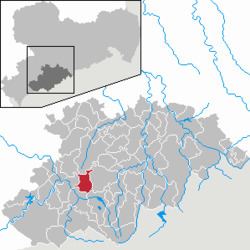Postal codes 08344 Local time Saturday 5:15 AM | Time zone CET/CEST (UTC+1/+2) Dialling codes 03774 Population 6,438 (31 Dec 2008) | |
 | ||
Weather -2°C, Wind SW at 8 km/h, 93% Humidity Points of interest Natur‑ und Wildpark, König‑Albert‑Turm, Spiegelwald, Dudelskirche | ||
Grünhain-Beierfeld is a town in the district of Erzgebirgskreis in Saxony, Germany lying 8 km east of Aue. It came into being on 1 January 2005 through the merger of the town of Grünhain and the community of Beierfeld.
Contents
- Map of GrC3BCnhain Beierfeld Germany
- Location
- Neighbouring communities
- Constituent communities
- Beierfeld
- Grnhain
- Waschleithe
- Amalgamations
- Museums
- Music
- Buildings
- Parks
- Sport
- Regular events
- Transport
- Media
- Education
- Sons and daughters of the town
- People with connections to the town
- References
Map of Gr%C3%BCnhain-Beierfeld, Germany
Location
The town lies in the northeast of the district. The highest point in the municipal area is the Spiegelwald (forest) at 738 m above sea level.
Neighbouring communities
In the north, the town borders on Zwönitz, in the east on Elterlein, in the south on Raschau, in the southwest on Schwarzenberg and in the west on Bernsbach and Lößnitz.
Constituent communities
Grünhain-Beierfeld has three of these:
Beierfeld
The area around Beierfeld was settled in the 12th century. As with most other places in the Ore Mountains, Beierfeld was laid out as a forest village (Waldhufendorf). The town’s name hints at Bavarian colonists (the first two syllables, “Beier” are pronounced the same way as the German word Bayer, which means “Bavarian”). In 1233, Beierfeld became a monastic domain with Meinhard II of Wirbene’s endowment of the Grünhain Monastery. The abbot at Grünhain thereby held jurisdiction over the community until the Reformation and he received rent and socage from it.
When mining came, however, the transition from a purely agricultural community to an industrially based one began. The cutlery makers’ rising fortunes in the 17th and 18th centuries as well as the plating industry’s in the 19th century established the town’s main fields of business. From beginnings in producing handmade house and kitchen machines grew factory production in large enterprises by the beginning of the 20th century.
Grünhain
Grünhain had its first documentary mention in 1150. The location on the salt road from Halle (Saale) to the Preßnitzer Pass and on to Bohemia convinced Cistercian monks to come and found a monastery here. In 1276, Grünhain was granted town rights. Until the 15th century, the monastery extended its sphere of influence, mainly through donations. At the onset of the Reformation, the monastery held sway over more than 56 villages and three towns. The Reformation and the Thirty Years' War were the monastery’s downfall.
Waschleithe
Waschleithe had its first documentary mention in 1531. Already by the 13th century, mining had begun in the Oswald Valley, where Waschleithe lies. Besides silver, tin and iron, marble was also later quarried. Mining continued until 1920. Mining also yielded the place’s name, which refers to an ore washing operation on a ridge.
Amalgamations
On 1 January 1999 came Waschleithe’s amalgamation with Beierfeld.
On 1 January 2005 came Grünhain’s and Beierfeld’s amalgamation, along with a name change to Grünhain-Beierfeld.
Museums
Music
Buildings
Parks
Sport
Regular events
The three festivals are held in turn, one each year.
Transport
Grünhain-Beierfeld is not connected to any other community by Federal Highway (Bundesstraße); however, the most important connections are the road to Schwarzenberg, near which runs the Bundesstraße 101, and the road to Zwönitz to a feeder road to the Bundesautobahn 72.
